Personal activity index to live 10 years longer: our five kopecks about Mio Slice
Mio Slice from Mio Global, despite the excitement around the announcement, went everywhere quite quietly. Some Western publications are still just writing reviews, although the gadget has been on sale officially since January 2017. Let's just say that the announcement with CES2016 was much more actively discussed than the finished piece of hardware.

In our opinion, the story with this tracker is amazing, and therefore we also put it off for a long time to talk about it out loud. First, it is still not clear what is PAI?
Mio, as it seems to us, when releasing a fitness tracker in 2017, it is strange, especially having authority among the professional audience of athletes. Moreover, the company sought it very, very consistently, including cooperating with Garmin !
')
Among the victories, Mio Global - a line of precise optics for any tasks, which in Russia thanks to moderate prices (the first Alpha has now returned, and see how much it costs!) Has gained recognition and gained fame.
And against this background - a fitness tracker, which has nothing to do with sports. Compete with Fitbit against their depressing situation, while the latter is trying to fix things in a completely different niche? Compete with whom?
What did Mio do? She took one study. Yes, just one thing, and this is pronounced in the company's own materials, and in other sources, which write in different languages about the new metric. And from this study took the PAI metric.
If you remember one of our retrospective materials on how a pedometer was created, then, speaking of the origins, it was said that the catch phrase about “10,000 steps a day” provided popularity to gadgets. MIO does the same, but not in steps: “Do 100 PAI a week and live 10 years longer”.
The source of the metric was, as has already been said, a study against which all other sources rest, and the MIO points it out, and the journalists . And everywhere it is emphasized that the research is long and “scientifically based”.
We believe, willingly believe, because by and large PAI, or personal activity index, motivates to physical exertion. In any case, such a conclusion suggests itself from all the same research, where physically active participants as a result then turned out to be further from the risk group for cardiovascular diseases, etc.
The PAI index is good: it is more honest. It is calculated individually depending on two units: a pulse at rest and a maximum pulse that are taken automatically, as well as a filled profile. That is, the prognosis of the heart depends on the current work of the heart. Is logical.
In general, we approve this approach: the heart is the best coordinator, so when in activity trackers, for example, calorie consumption is strictly dependent on the activity shown: more like - burned more, we are slightly on the alert. Athletes also consider the goal of calorie consumption from the pulse .
What might seem like PAI? The fact that it is calculated for each individual user according to the “patented MIO algorithm”, which they derived based on the research results among 45,000 volunteers, men and women. That is, from you - you don’t need to think out anything, and the application doesn’t give much: basic calibration, and - go ahead, to 100 PAI!
After all - and this is a unique tracker in this sense today, and with a heart rate monitor, to which there is already enough credibility! And it should work. And we have to believe that, with the ability to accurately measure the pulse, the MIO will lead us to success and longevity, as far as possible.
The company is developing the topic very actively, in any case, besides the native PAI application for the Slice tracker, there is a similar one for Mio Fuse, Alpha and Link . That is, users who do not want to buy a new gadget, but who would like to have a new opportunity are welcome.
Whats up slice As a result: we get more “medgadzhet”, which is designed to reduce the risks of diseases that can be triggered by insufficient activity, and within the framework of loads that are safe for each specific user. And this is interesting and cool: another very prominent and reputable player enters the mHealth path almost in its purest form.
Tracker
The bracelet works in tandem with the proprietary PAI application of the second version : it is Russified. Only three simple menus, the central of which and the first in a row will be the statistics of PAI.

Since the screenshots should have caused you a couple of questions about this metric, we will again retreat. The PAI, or the personal activity index that the MIO suggests, is a moving value that is automatically calculated: the pulse is taken from the tracker data at rest, the maximum pulse is predicted, and that’s it.
On the first day, the corridor was as follows: 70–120. And for the first day, 75 PAI quietly “dripped”, which, at a rate of 100 per week, makes the owner of such indicators “immortal”. Then the tracker was reset to zero, and the lower number was automatically changed to 54. We calculated the upper limit using the calculator 220 — age. The morning showed that everything was in vain.
In fact, in the minibus, the second number was shifted to the original 120, and so far reached the office - PAI grew by 3 units. So.
It turns out that the PAI metric can be controlled by the user in addition to the “mathematics” from MIO: the achievement of the norm depends on how long your heart has been under load, and therefore, on what upper limit you set for yourself. The lower limit can not touch, relying on the night pulse at rest.
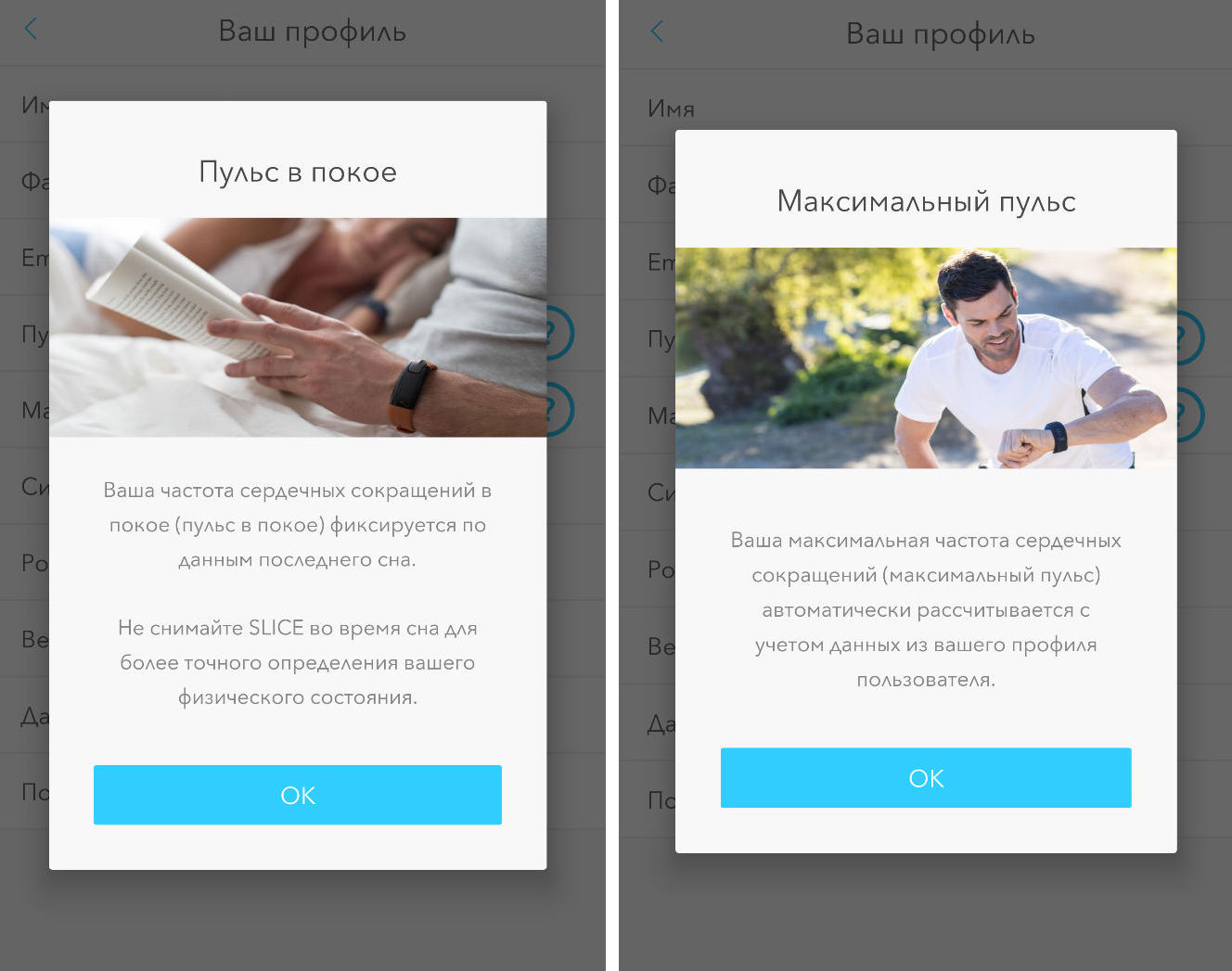
It is noteworthy that your daily goal will be moving, since the pulse at rest can vary, and today you will need one load, one type of action, another tomorrow; today you must be more mobile, tomorrow less. The imperfection of the algorithm is that it can be fooled by one button.
But not only! In both domestic and foreign reviews, a curious detail was noted that needs to be said: MIO Slice is not needed in the gym, in other words, it is not intended for strength training, and this is the most surprising.
Users noticed that power loads that have a great effect on heart rate in a big way can not affect the daily rate of PAI, and simple walks are easy. From this it is concluded that “mobile hands” during sports play a significant role in the analysis of daily activity. Why?
Perhaps because of the delicacy: suppose you are a bed patient in the last minutes (God forbid, of course), and your heart rate is already 200/210/220 ... In five minutes you are already there, and Slice shows, they say, you will live a long time and happily. Therefore, the overall mobility is taken into account.
In this regard, among the recommendations for this tracker are usually loads such as aerobics, jogging and other fitness activities, where the hands are somehow involved. In this sense, many will say, they say, Slice is not so far gone from many fellows, but in this case, we again rest on a pulse.
If you walk with the tracker 5-7 thousand steps at a normal pace without a load on the heart, you will not get any PAI. Which is logical, because an ordinary walk is a waste of time that will not help you in the future. That is, MIO seems to kill a stereotype that has been around for decades: 10,000 steps are henceforth useless.
Moreover, unlike other trackers, MIO turns on instantly, as it works constantly: the dog chased after you, and a regular pedometer will take into account steps and calories, and MIO will turn on the heart rate monitor and evaluate the quality of your physical activity “from and to”, until as you come off the beast.
No less valuable is the second screen of the application: here the data on physical activity, sleep, pulse. Data about steps, calories, distance tracker, of course, considers, but it does so rather so that the picture is even more dissonant.
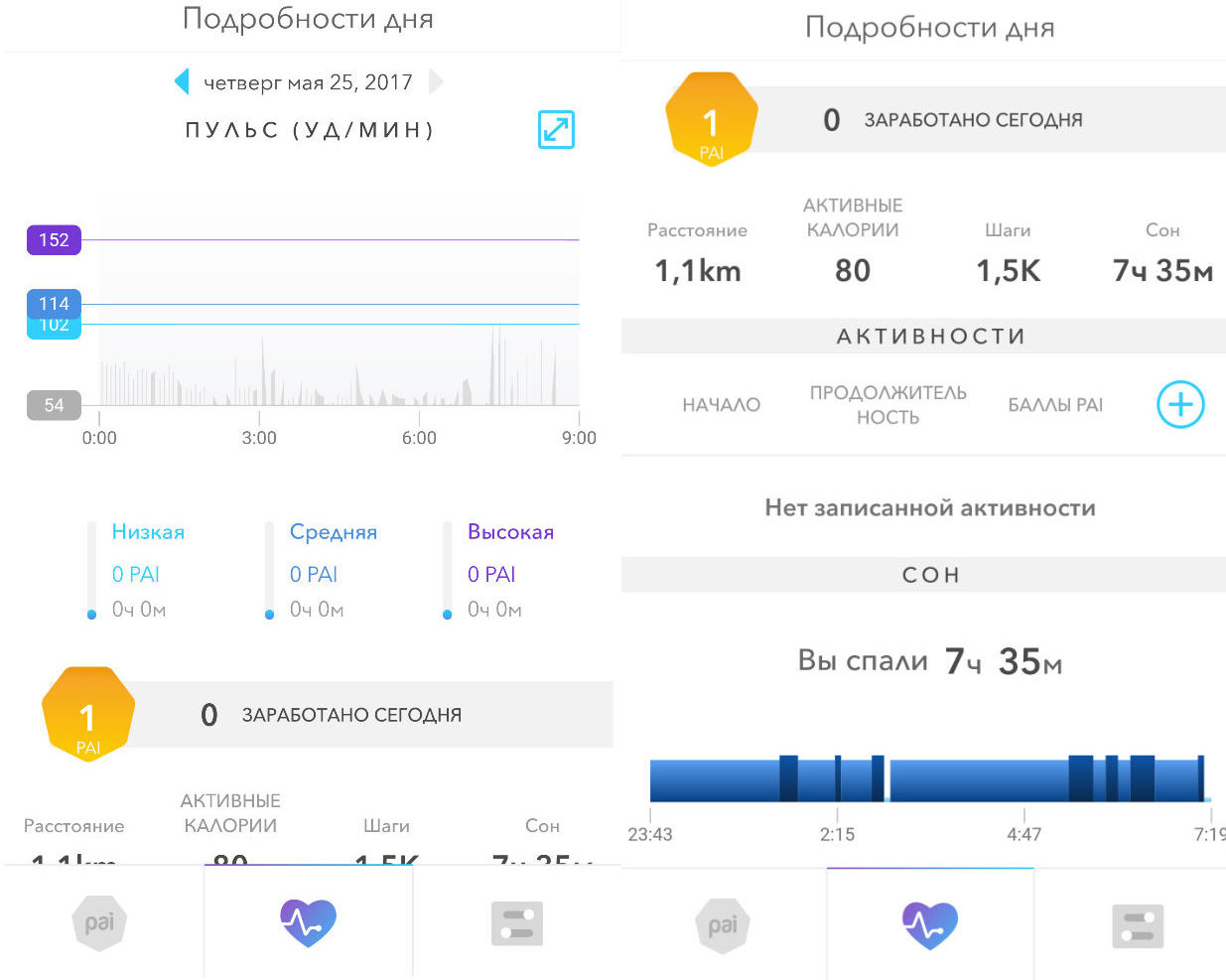
How so? I walked 1000 steps, 1 kilometer, burned so many calories, and I have 0 PAI? And all because the load on the heart was not. Well, as they say, thank you for statuses and icons, such as "lazy" or "turtle" do not assign.
And the third screen is settings. Here you can see the connection status of the tracker, from here you go to your personal profile, manage the settings of the bracelet and find out what PAI is.

PAI information is deployed in a few simple slides, described in simple words. You will not learn anything new, but in general it sounds quite optimistic and even motivates!
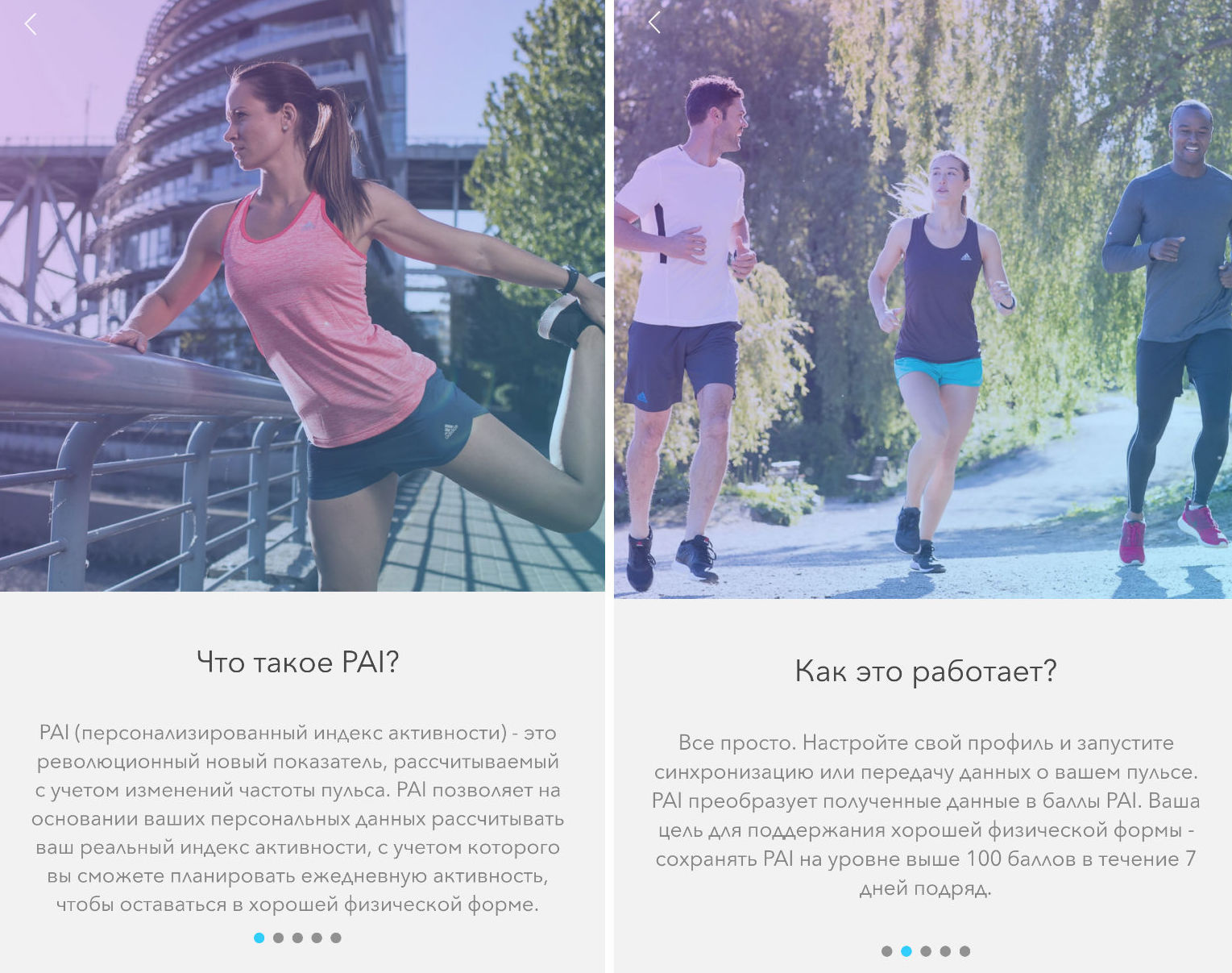
You will certainly notice that in all the pictures people are running, in other words, with such activity, where both hands and heart are involved. For those who believe that Slice is “deceiving” them, the developers have foreseen the manual addition of activity: this will allow to correct the error if it is obvious to you.

According to the application, you can put a solid five: comfortable, nothing superfluous, available in Russian. No pitfalls and hidden presets - take it and run.
But, for a moment. The main thing, of course, is the pulse. In general, MIO Slice is not least the heart rate monitor, which measures the pulse continuously. Are there many of them on the market? And Slice put on, went, and he writes. One-second changes you can see on the display screen or on the main screen of the application, he writes minute intervals during the day, and slightly increased 15-minute intervals - at night.
Yes, this alone is enough for many to make their choice in favor of the bracelet. For example, many of us do not lead an overactive lifestyle, and constantly seeing the pulse is a good advantage if you are able to draw the right conclusions. Counts the steps and let him count. Moreover, it now does not commit to anything, and the constant heart rate monitor is great.
The pulse menu, which you see by default is not very informative: it is better to expand it.

And then we stretch it out, tych fingers and look at the minutes, what and how it was for a certain period. It's pretty simple. On the left are the PAI zones, similar to the pulse zones: low, medium, high with maximum figures for the period.
In general, everything turned out to be quite nice and understandable, despite the automatic algorithms, adjustable, and of course, a constant pulse! As they say, “yabkupil”, but always - a matter of price, and Slice now costs 8900 rubles .
A few words about the design
A short survey within the team showed that no one had experienced negative appearance. But the fact is that all Western reviews start with the fact that Slice has a different design. And PC-mag writes that it is unfashionable, and TechRadar, won, says that the design is boring.
In connection with this question? And name, guys, a couple of fitness trackers, the design of which can be called a reference? Perhaps a little unjustified expectations affected: Mio Slice really should have been a little less, a little more concise. At the start of the launch campaign, he did not have a button and clearly met the modern requirements for touchscreen displays:
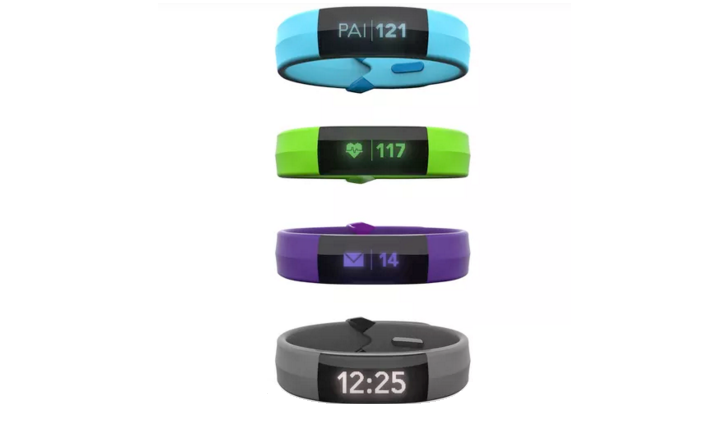
Now we have a simple device that is controlled by pressing a button, it has three modes of display brightness, a rubber strap. In general, one cannot say that they have thoughtlessly approached: some details just say the opposite, for example, the strap strip also continues on the button, creating an imitation of a single whole. Label on the clasp. Everything is done with love.
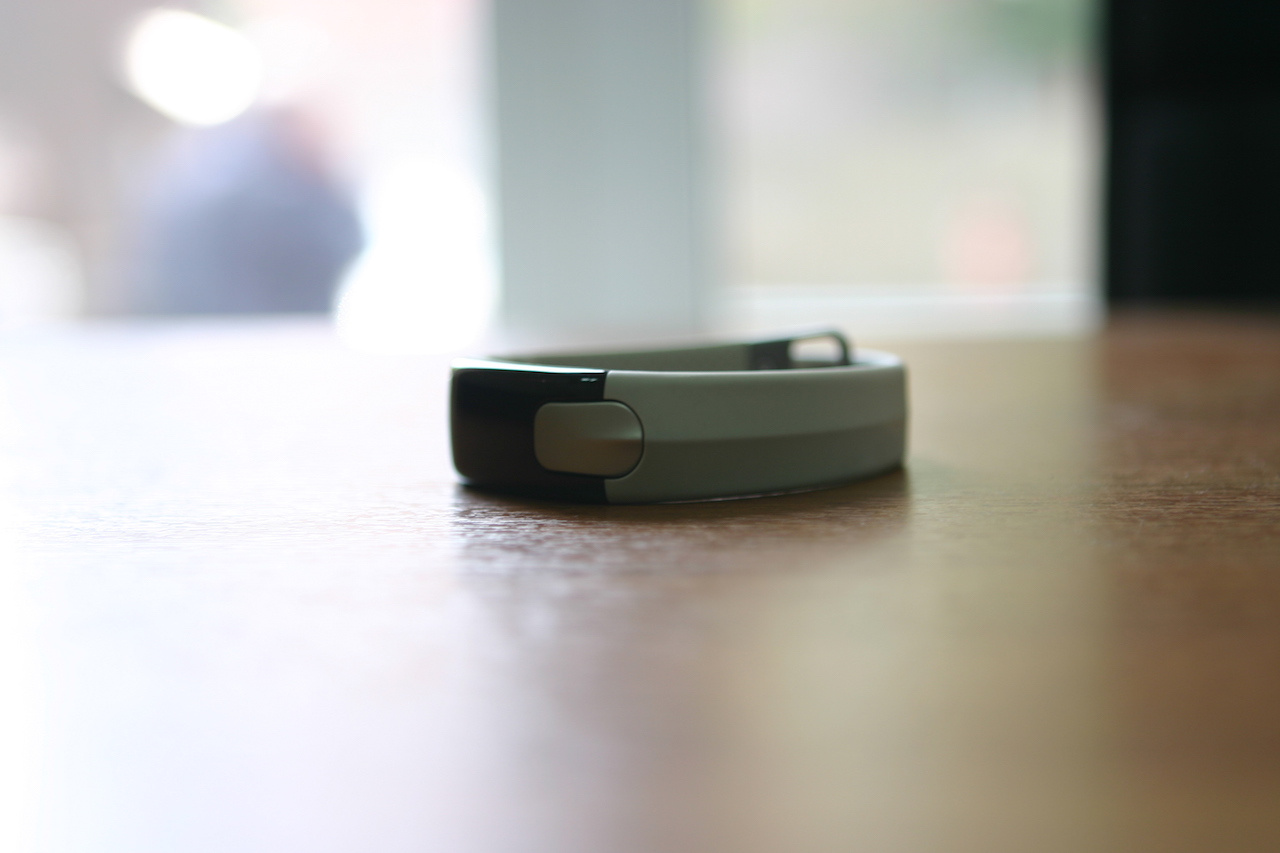
The main control is carried out by pressing, and one-time "tyts" will help you to move between screens.
Also, holding the button for a long time will start the workout and stop it, and the superlong (within 15 seconds), provided that the tracker is connected to the power supply, the Slice will reboot and reset. In order to charge the gadget, you need to connect it to the proprietary non-universal charging that comes with it.
Autonomy is still a difficult question. The basic promise is up to five days, someone, judging by the reviews, is enough, someone is not. Recently, the figure of 4-5 days in the mode of permanent operation. Taking into account how we used it, the brightness was changed, and the resets were, in general, applied permits, probably about enough for three days now, taking into account the starting charge, about 80 percent. So, it seems to be true.
Charging is connected to the gadget on the back side, where the heart rate monitor is located:

As a summary
We tracker seemed interesting and unique. Indeed, it should be easier to predict the physical state, considering the work of the heart, and not of the legs, as is common due to the abundance of pedometers and trackers. At the same time, to say that MIO, like many now shifted to medicine, is still difficult, because the forecasts are too distant.
Loads Slice recommends individually, taking into account the automatic measurements of your pulse , and he does it for sure: MIO gadgets have already confirmed their accuracy more than once, and this is true. The device summarizes its recommendations, leaving the user some choice on the loads, and not this “it's time to go”, “go over”, etc.
Planning and controlling success is easier: there is a whole week for this. This is important for those who, for example, go for a run not every day, but according to an individual schedule. So, if you missed one day, you can easily catch up. Double-edged stick? Maybe. If you fanatically strive to dial a hundred on the last day, then you can hurt yourself, but Slice is addressed to adequate people.
Manage tracker clear, convenient. Application Russified, simple and intuitive. The key advantage, in addition to the first proposed metric, is a constant pulse, and as a constant heart rate monitor, many more people can use it to track the work of the heart.
At this our late review comes to the final.

Take care and be healthy!
In our opinion, the story with this tracker is amazing, and therefore we also put it off for a long time to talk about it out loud. First, it is still not clear what is PAI?
Mio, as it seems to us, when releasing a fitness tracker in 2017, it is strange, especially having authority among the professional audience of athletes. Moreover, the company sought it very, very consistently, including cooperating with Garmin !
')
Among the victories, Mio Global - a line of precise optics for any tasks, which in Russia thanks to moderate prices (the first Alpha has now returned, and see how much it costs!) Has gained recognition and gained fame.
And against this background - a fitness tracker, which has nothing to do with sports. Compete with Fitbit against their depressing situation, while the latter is trying to fix things in a completely different niche? Compete with whom?
What did Mio do? She took one study. Yes, just one thing, and this is pronounced in the company's own materials, and in other sources, which write in different languages about the new metric. And from this study took the PAI metric.
If you remember one of our retrospective materials on how a pedometer was created, then, speaking of the origins, it was said that the catch phrase about “10,000 steps a day” provided popularity to gadgets. MIO does the same, but not in steps: “Do 100 PAI a week and live 10 years longer”.
The source of the metric was, as has already been said, a study against which all other sources rest, and the MIO points it out, and the journalists . And everywhere it is emphasized that the research is long and “scientifically based”.
We believe, willingly believe, because by and large PAI, or personal activity index, motivates to physical exertion. In any case, such a conclusion suggests itself from all the same research, where physically active participants as a result then turned out to be further from the risk group for cardiovascular diseases, etc.
The PAI index is good: it is more honest. It is calculated individually depending on two units: a pulse at rest and a maximum pulse that are taken automatically, as well as a filled profile. That is, the prognosis of the heart depends on the current work of the heart. Is logical.
In general, we approve this approach: the heart is the best coordinator, so when in activity trackers, for example, calorie consumption is strictly dependent on the activity shown: more like - burned more, we are slightly on the alert. Athletes also consider the goal of calorie consumption from the pulse .
What might seem like PAI? The fact that it is calculated for each individual user according to the “patented MIO algorithm”, which they derived based on the research results among 45,000 volunteers, men and women. That is, from you - you don’t need to think out anything, and the application doesn’t give much: basic calibration, and - go ahead, to 100 PAI!
After all - and this is a unique tracker in this sense today, and with a heart rate monitor, to which there is already enough credibility! And it should work. And we have to believe that, with the ability to accurately measure the pulse, the MIO will lead us to success and longevity, as far as possible.
The company is developing the topic very actively, in any case, besides the native PAI application for the Slice tracker, there is a similar one for Mio Fuse, Alpha and Link . That is, users who do not want to buy a new gadget, but who would like to have a new opportunity are welcome.
Whats up slice As a result: we get more “medgadzhet”, which is designed to reduce the risks of diseases that can be triggered by insufficient activity, and within the framework of loads that are safe for each specific user. And this is interesting and cool: another very prominent and reputable player enters the mHealth path almost in its purest form.
Tracker
The bracelet works in tandem with the proprietary PAI application of the second version : it is Russified. Only three simple menus, the central of which and the first in a row will be the statistics of PAI.

Since the screenshots should have caused you a couple of questions about this metric, we will again retreat. The PAI, or the personal activity index that the MIO suggests, is a moving value that is automatically calculated: the pulse is taken from the tracker data at rest, the maximum pulse is predicted, and that’s it.
On the first day, the corridor was as follows: 70–120. And for the first day, 75 PAI quietly “dripped”, which, at a rate of 100 per week, makes the owner of such indicators “immortal”. Then the tracker was reset to zero, and the lower number was automatically changed to 54. We calculated the upper limit using the calculator 220 — age. The morning showed that everything was in vain.
In fact, in the minibus, the second number was shifted to the original 120, and so far reached the office - PAI grew by 3 units. So.
It turns out that the PAI metric can be controlled by the user in addition to the “mathematics” from MIO: the achievement of the norm depends on how long your heart has been under load, and therefore, on what upper limit you set for yourself. The lower limit can not touch, relying on the night pulse at rest.

It is noteworthy that your daily goal will be moving, since the pulse at rest can vary, and today you will need one load, one type of action, another tomorrow; today you must be more mobile, tomorrow less. The imperfection of the algorithm is that it can be fooled by one button.
But not only! In both domestic and foreign reviews, a curious detail was noted that needs to be said: MIO Slice is not needed in the gym, in other words, it is not intended for strength training, and this is the most surprising.
Users noticed that power loads that have a great effect on heart rate in a big way can not affect the daily rate of PAI, and simple walks are easy. From this it is concluded that “mobile hands” during sports play a significant role in the analysis of daily activity. Why?
Perhaps because of the delicacy: suppose you are a bed patient in the last minutes (God forbid, of course), and your heart rate is already 200/210/220 ... In five minutes you are already there, and Slice shows, they say, you will live a long time and happily. Therefore, the overall mobility is taken into account.
In this regard, among the recommendations for this tracker are usually loads such as aerobics, jogging and other fitness activities, where the hands are somehow involved. In this sense, many will say, they say, Slice is not so far gone from many fellows, but in this case, we again rest on a pulse.
If you walk with the tracker 5-7 thousand steps at a normal pace without a load on the heart, you will not get any PAI. Which is logical, because an ordinary walk is a waste of time that will not help you in the future. That is, MIO seems to kill a stereotype that has been around for decades: 10,000 steps are henceforth useless.
Moreover, unlike other trackers, MIO turns on instantly, as it works constantly: the dog chased after you, and a regular pedometer will take into account steps and calories, and MIO will turn on the heart rate monitor and evaluate the quality of your physical activity “from and to”, until as you come off the beast.
No less valuable is the second screen of the application: here the data on physical activity, sleep, pulse. Data about steps, calories, distance tracker, of course, considers, but it does so rather so that the picture is even more dissonant.

How so? I walked 1000 steps, 1 kilometer, burned so many calories, and I have 0 PAI? And all because the load on the heart was not. Well, as they say, thank you for statuses and icons, such as "lazy" or "turtle" do not assign.
And the third screen is settings. Here you can see the connection status of the tracker, from here you go to your personal profile, manage the settings of the bracelet and find out what PAI is.

PAI information is deployed in a few simple slides, described in simple words. You will not learn anything new, but in general it sounds quite optimistic and even motivates!

You will certainly notice that in all the pictures people are running, in other words, with such activity, where both hands and heart are involved. For those who believe that Slice is “deceiving” them, the developers have foreseen the manual addition of activity: this will allow to correct the error if it is obvious to you.

According to the application, you can put a solid five: comfortable, nothing superfluous, available in Russian. No pitfalls and hidden presets - take it and run.
But, for a moment. The main thing, of course, is the pulse. In general, MIO Slice is not least the heart rate monitor, which measures the pulse continuously. Are there many of them on the market? And Slice put on, went, and he writes. One-second changes you can see on the display screen or on the main screen of the application, he writes minute intervals during the day, and slightly increased 15-minute intervals - at night.
Yes, this alone is enough for many to make their choice in favor of the bracelet. For example, many of us do not lead an overactive lifestyle, and constantly seeing the pulse is a good advantage if you are able to draw the right conclusions. Counts the steps and let him count. Moreover, it now does not commit to anything, and the constant heart rate monitor is great.
The pulse menu, which you see by default is not very informative: it is better to expand it.

And then we stretch it out, tych fingers and look at the minutes, what and how it was for a certain period. It's pretty simple. On the left are the PAI zones, similar to the pulse zones: low, medium, high with maximum figures for the period.
In general, everything turned out to be quite nice and understandable, despite the automatic algorithms, adjustable, and of course, a constant pulse! As they say, “yabkupil”, but always - a matter of price, and Slice now costs 8900 rubles .
A few words about the design
A short survey within the team showed that no one had experienced negative appearance. But the fact is that all Western reviews start with the fact that Slice has a different design. And PC-mag writes that it is unfashionable, and TechRadar, won, says that the design is boring.
In connection with this question? And name, guys, a couple of fitness trackers, the design of which can be called a reference? Perhaps a little unjustified expectations affected: Mio Slice really should have been a little less, a little more concise. At the start of the launch campaign, he did not have a button and clearly met the modern requirements for touchscreen displays:

Now we have a simple device that is controlled by pressing a button, it has three modes of display brightness, a rubber strap. In general, one cannot say that they have thoughtlessly approached: some details just say the opposite, for example, the strap strip also continues on the button, creating an imitation of a single whole. Label on the clasp. Everything is done with love.
The main control is carried out by pressing, and one-time "tyts" will help you to move between screens.
Slice menu
Here are two PAI screens: common and present.
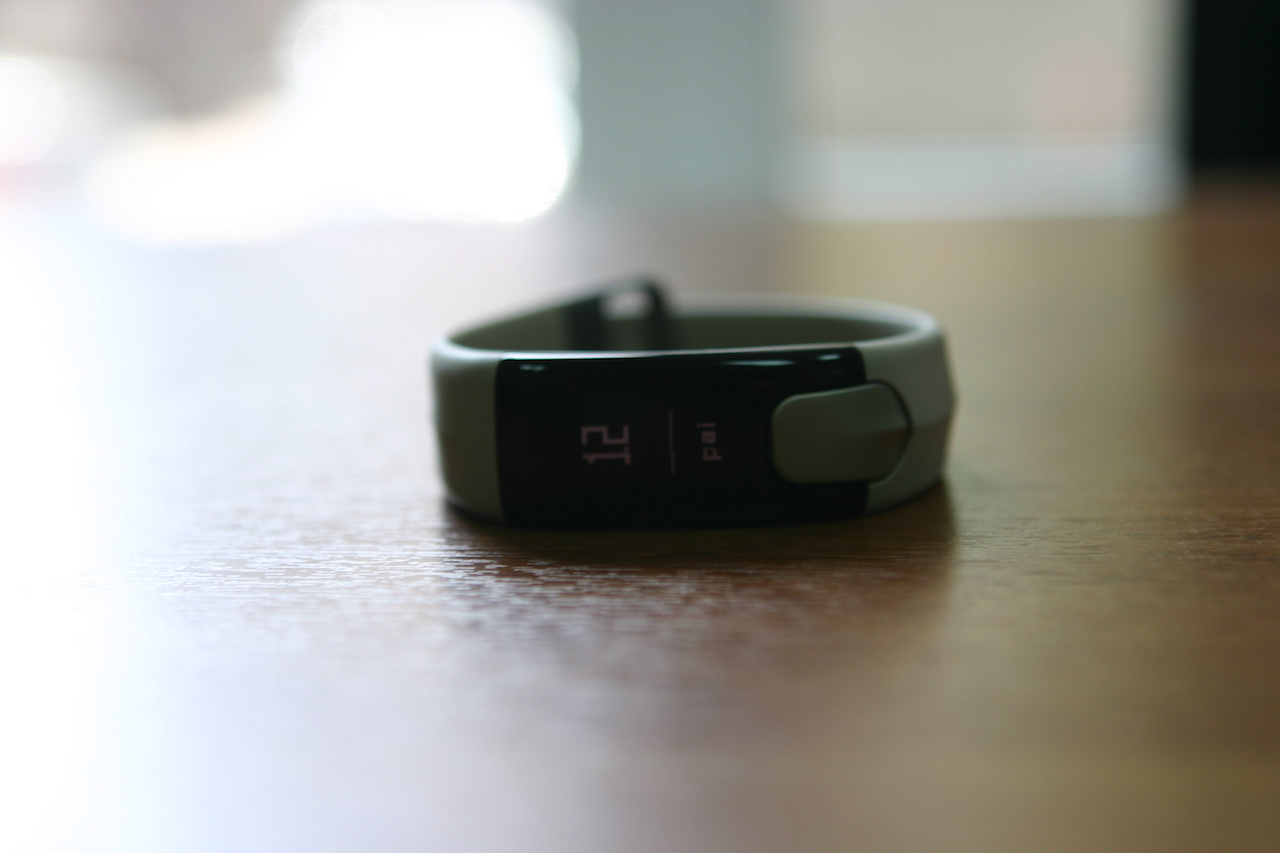
On today's there is a scale to achieve the following unit: as soon as the strip reaches the end, the number changes, and a new “slider” begins.

Also here are all the basic metrics: time, steps, calories, distance, sleep and pulse.


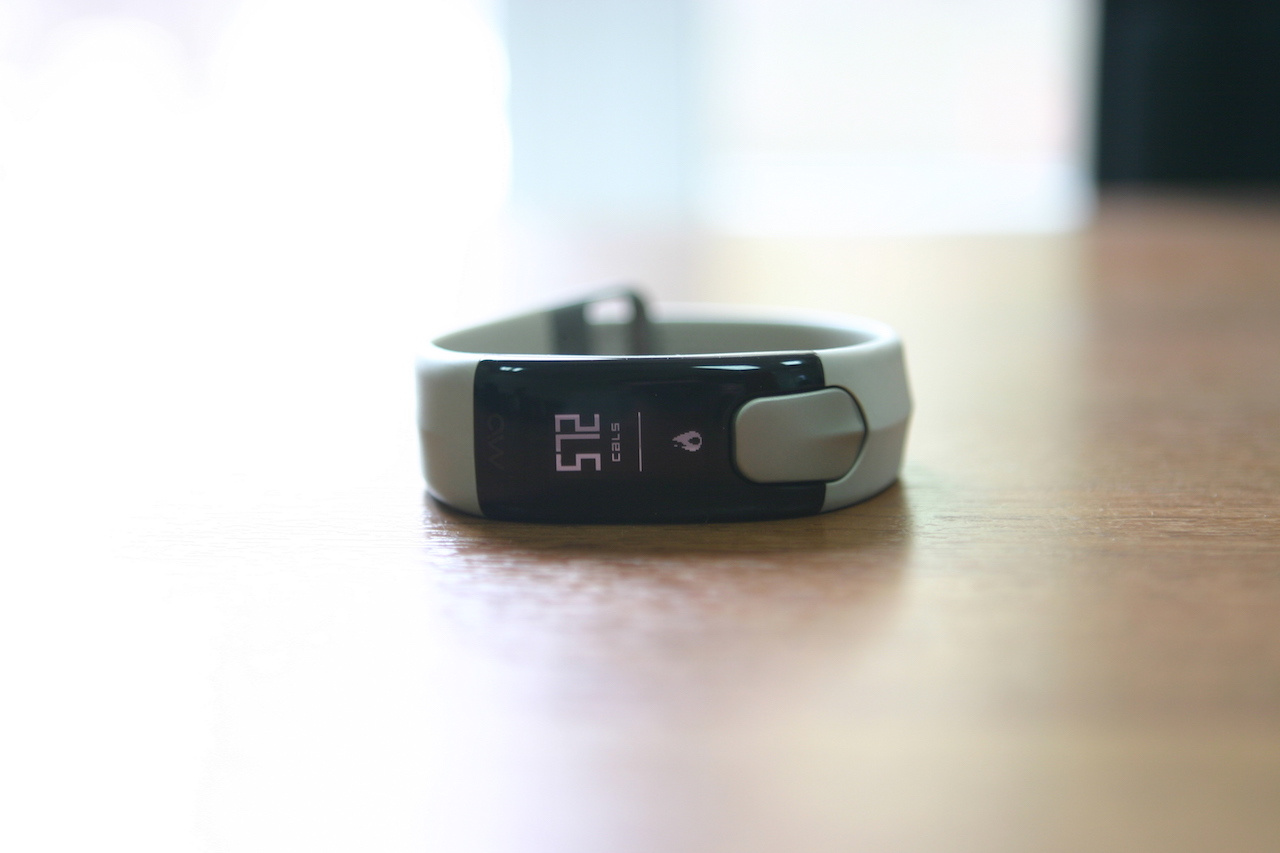

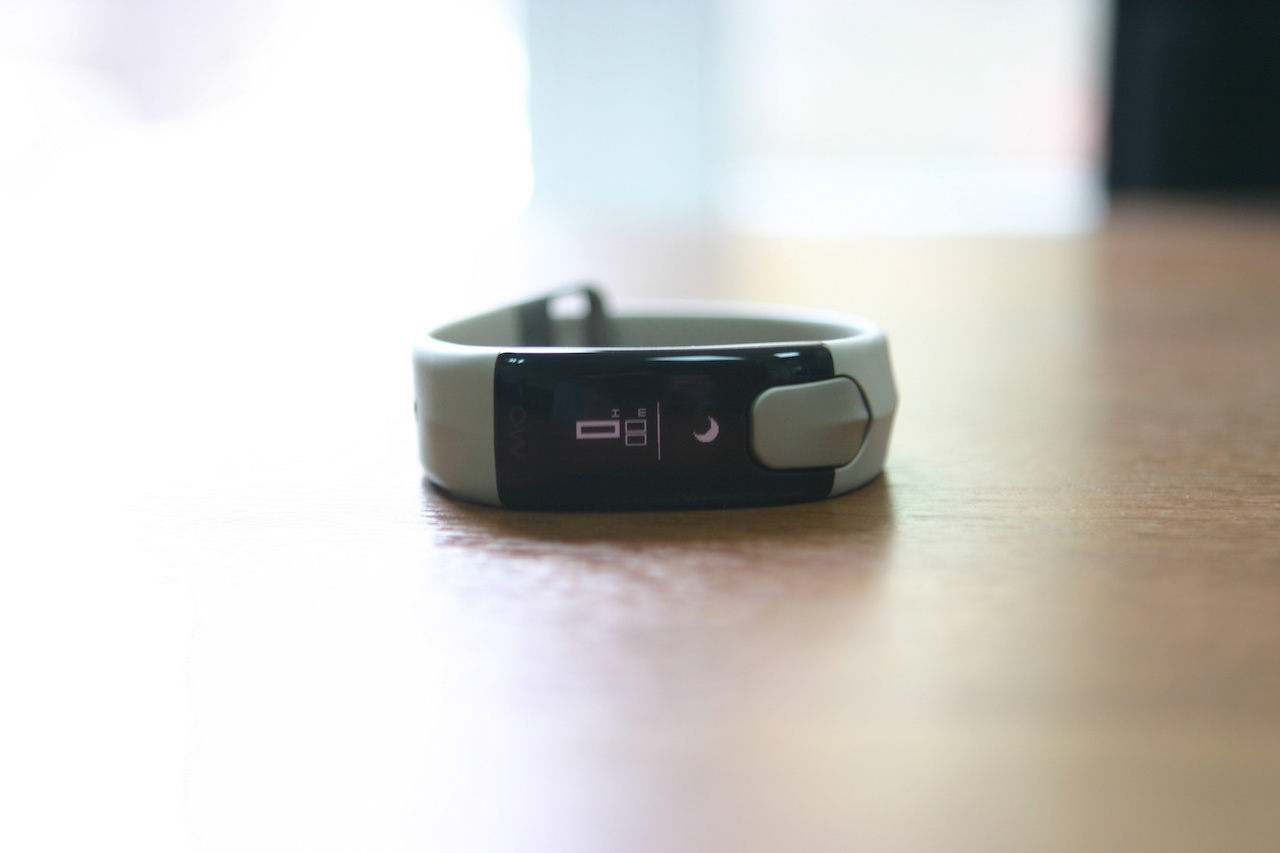

If you don’t want to see any of this on the screen, then this can be controlled in the application settings.
On today's there is a scale to achieve the following unit: as soon as the strip reaches the end, the number changes, and a new “slider” begins.
Also here are all the basic metrics: time, steps, calories, distance, sleep and pulse.
If you don’t want to see any of this on the screen, then this can be controlled in the application settings.
Also, holding the button for a long time will start the workout and stop it, and the superlong (within 15 seconds), provided that the tracker is connected to the power supply, the Slice will reboot and reset. In order to charge the gadget, you need to connect it to the proprietary non-universal charging that comes with it.
Autonomy is still a difficult question. The basic promise is up to five days, someone, judging by the reviews, is enough, someone is not. Recently, the figure of 4-5 days in the mode of permanent operation. Taking into account how we used it, the brightness was changed, and the resets were, in general, applied permits, probably about enough for three days now, taking into account the starting charge, about 80 percent. So, it seems to be true.
Charging is connected to the gadget on the back side, where the heart rate monitor is located:
As a summary
We tracker seemed interesting and unique. Indeed, it should be easier to predict the physical state, considering the work of the heart, and not of the legs, as is common due to the abundance of pedometers and trackers. At the same time, to say that MIO, like many now shifted to medicine, is still difficult, because the forecasts are too distant.
Loads Slice recommends individually, taking into account the automatic measurements of your pulse , and he does it for sure: MIO gadgets have already confirmed their accuracy more than once, and this is true. The device summarizes its recommendations, leaving the user some choice on the loads, and not this “it's time to go”, “go over”, etc.
Planning and controlling success is easier: there is a whole week for this. This is important for those who, for example, go for a run not every day, but according to an individual schedule. So, if you missed one day, you can easily catch up. Double-edged stick? Maybe. If you fanatically strive to dial a hundred on the last day, then you can hurt yourself, but Slice is addressed to adequate people.
Manage tracker clear, convenient. Application Russified, simple and intuitive. The key advantage, in addition to the first proposed metric, is a constant pulse, and as a constant heart rate monitor, many more people can use it to track the work of the heart.
For those who wanted to buy Slice, but did not know how
Itself, as a gift, it does not matter . But in each case it is better to use a coupon for a discount of 1000 rubles: WBKSDF *
* Coupon valid for payment on the site: in the basket you need to select the appropriate method of payment.
* Coupon valid for payment on the site: in the basket you need to select the appropriate method of payment.
At this our late review comes to the final.

Take care and be healthy!
Source: https://habr.com/ru/post/373485/
All Articles